Lessico
Nespolo
Nespolo
comune
Mespilus germanica
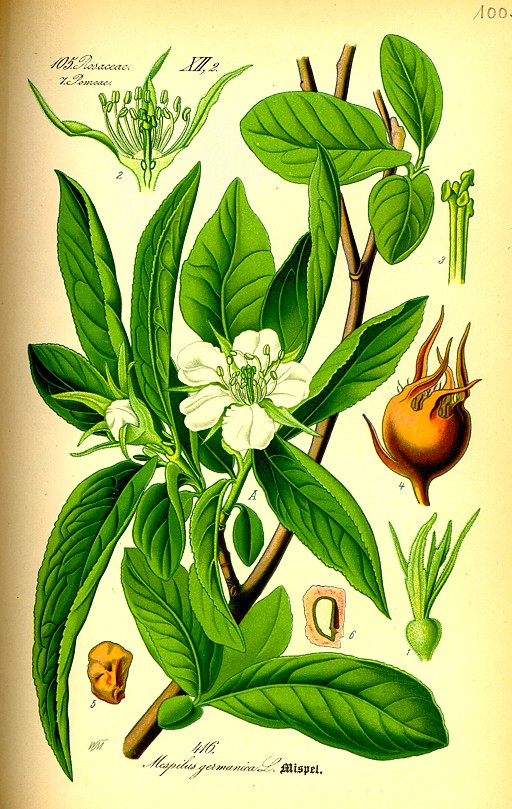
In greco antico il nespolo suona méspilon. Il nespolo comune (Mespilus germanica) appartiene alla famiglia Rosaceae. Il nespolo comune non deve essere confuso con il nespolo del Giappone. I termini di nespolo e nespola, nel lessico comune, fanno infatti riferimento in genere all'albero e ai frutti di quello del Giappone, Eriobotrya japonica.
Il nespolo comune è diffuso in natura nell'Europa meridionale (fino alla
Germania) e nell'Asia Minore, secondo alcuni anzi sarebbe originario di
quest'ultima. Esso è comunque presente anche nell'Italia settentrionale, dal
Piemonte al Veneto. In alcuni comuni delle vallate piemontesi questa pianta è
al centro di feste tradizionali: a Farigliano in provincia di Cuneo a fine
novembre inizio dicembre si svolge una festa dedicata a San Nicolao abbinata
alla Fiera dei Puciu (appunto, i nespoli), mentre a Trinità![]() in
provincia di Cuneo l'ultima domenica di novembre si svolge la "Fera di
Pocio e Bigat", giunta quest'anno (2007) all'ottava edizione e
riproposta, dopo un periodo d'interruzione durato 50 anni, nel 2000, che
associa il nespolo (Pocio) al baco da seta (Bigat).
in
provincia di Cuneo l'ultima domenica di novembre si svolge la "Fera di
Pocio e Bigat", giunta quest'anno (2007) all'ottava edizione e
riproposta, dopo un periodo d'interruzione durato 50 anni, nel 2000, che
associa il nespolo (Pocio) al baco da seta (Bigat).
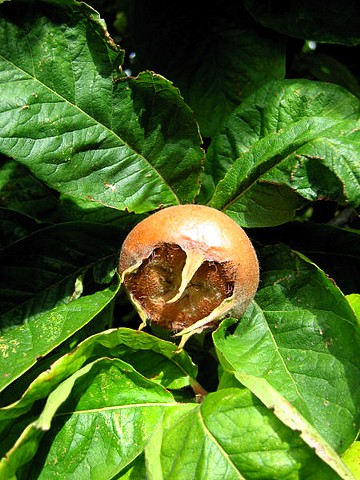
Il frutto (nespola) è globoso, bruno, con calice persistente, che, staccato dalla pianta e conservato nella paglia, fermenta diventando zuccherino e aromatico. Da questo frutto si trae un liquore di sapore dolce e gradevole. Da degustare a Trinità i famosi dolci farciti di marmellata ai "pocio".
Nel 1990 sono state scoperte alcune piante attribuibili al genere Mespilus nell'Arkansas. Per queste piante (circa 25 esemplari in tutto, ristretti a un unico bosco) è stata descritta una specie nuova, Mespilus canescens, che risulta una specie a fortissimo rischio di estinzione, dato il suo ristrettissimo areale e le scarse capacità riproduttive manifestate in questi anni.
Medlar (Mespilus) is a genus of two species of flowering plants in the subfamily Maloideae of the family Rosaceae. One, Common Medlar Mespilus germanica, is a long-known native of southwest Asia and possibly also south-eastern Europe, and the other, Stern's Medlar Mespilus canescens, was recently discovered in North America (1990).
At least two cultivars of Mespilus germanica are sold in the United States, the Macrocarpa medlar and the Royal medlar.
Medlars are deciduous large shrubs or small trees growing up to 8 m tall. The leaves are dark green and elliptic, six to fifteen centimetres long and three to four centimetres wide. The leaves turn a spectacular red in autumn before falling. The five-petalled white flowers are produced in late spring. The fruit is a pome, two to three centimetres in diameter, with wide-spreading persistent sepals giving a "hollow" appearance to the fruit; it is matte brown in Mespilus germanica and glossy red in Mespilus canescens.
Medlar fruit are very hard and acidic. They become edible after being softened ("bletted") by frost, or naturally in storage given sufficient time. Once softening begins, the skin rapidly takes a wrinkled texture and turns dark brown, and the inside reduces to a consistency and flavour reminiscent of apple sauce. They can then be eaten raw, often consumed with cheese as a dessert, although they are also used to make medlar jelly and wine. Another dish is "medlar cheese", which is similar to lemon curd, being made with the fruit pulp, eggs, and butter.
The medlar is native to Persia and has an ancient history of cultivation; it was grown by the ancient Greeks and Romans, beginning in the 2nd century BCE. The medlar was a very popular fruit during the Victorian era; however, it is now a rarely appreciated fruit, except in certain areas, such as the north of Iran.
Mousmoulia is the name of the tree in modern Greek and Mousmoulo the name of the fruit. Very appreciated especially in northern Greece in the area of Macedonia.
The genus Eriobotrya (loquats) is related, and sometimes called the "Japanese Medlar". Other related genera include Crataegus (hawthorns), and Sorbus (rowans, whitebeams, service trees).
In literature
A fruit which is rotten before it is ripe, the medlar is used figuratively in literature as a symbol of prostitution or premature destitution. For example, in the Prologue to The Reeve's Tale, Geoffrey Chaucer's character laments:
This white top advertises my old years,
My heart, too, is as mouldy as my hairs,
Unless I fare like medlar, all perverse.
For that fruit's never ripe until it's worse,
And falls among the refuse or in straw.
We ancient men, I fear, obey this law:
Until we're rotten, we cannot be ripe;
In Shakespeare's Measure for Measure, Lucio excuses his denial of past
fornication because "they would else have married me to the rotten medlar."
(IV.iii.171).
In Cervantes's Don Quixote the eponymous hero and Sancho Panza "Stretch
themselves out in the middle of a field and stuff themselves with acorns or
medlars."
In the 16th and 17th centuries, medlars were also bawdily called "open-arses" because of the shape of the fruits, inspiring the presence of boisterously or humorously indecent puns in many Elizabethan and Jacobean plays.
The most famous reference to medlars, often bowdlerized until modern editions accepted it, appears in Shakespeare's Romeo and Juliet, when Mercutio laughs at Romeo's unrequited love for his mistress Rosaline (II, 1, 34-38):
Now will he sit under a medlar tree,
And wish his mistress were that kind of fruit
As maids call medlars, when they laugh alone.
O Romeo, that she were, O that she were
An open-arse and thou a poperin pear!
Thomas Dekker also draws a saucy comparison in his play The Honest Whore: "I scarce know her, for the beauty of her cheek hath, like the moon, suffered strange eclipses since I beheld it: women are like medlars._no sooner ripe but rotten"
Another reference can be found in Thomas Middleton's A Trick to Catch the Old One in the character of Widow Medler, impersonated by a courtesan, hence the following pun: "Who? Widow Medler? She lies open to much rumour." (II, 2, 59).
In modern literature, some writers have also mentioned this fruit:
Saki uses medlars in his short stories, which often play on the decay of Edwardian society. In "The Peace of Mowsle Barton", the outwardly quiet farmstead features a medlar tree and corrosive hatred. In "The Boar Pig", the titular animal, Tarquin Superbus, is the point of contact between society ladies cheating to get into the garden party of the season and a not entirely honest young schoolgirl who lures him away by strategically throwing well-bletted medlars: "Come, Tarquin, dear old boy; you know you can't resist medlars when they're rotten and squashy."
D.H. Lawrence: "Wineskins of brown morbidity, autumnal excrementa ... an exquisite odour of leave taking"
Vladimir Nabokov in Ada briefly mentions a poet named Max Mispel, "another botanical name".
Common
medlar
Mespilus germanica
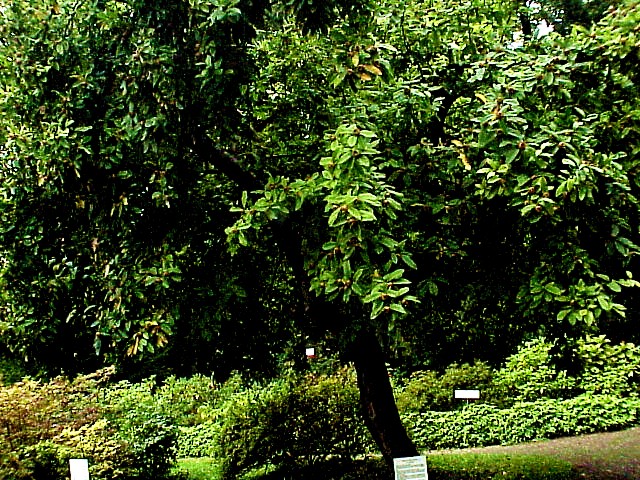
The Common Medlar (Mespilus germanica) is a large shrub or small tree, and the name of the fruit of this tree. Despite its Latin name, which means German or Germanic Medlar, it is indigenous to southwest Asia and possibly also southeastern Europe, and was introduced to Germany by the Romans.
Until recently, the Common Medlar was the only known species of medlar (see this article for more general cultural information). However, in 1990 a new species was discovered in North America, now named Stern's Medlar (Mespilus canescens). The Loquat (Eriobotrya japonica) is also related, and sometimes called the "Japanese Medlar".
The Common Medlar requires warm summers and mild winters and prefers sunny, dry locations and slightly acidic soil. Under ideal circumstances, the deciduous plant grows up to 8 m tall. Generally, it is shorter and more shrub-like than tree-like. With a lifespan of 30–50 years, the Common Medlar is rather short-lived. Common Medlar leaves are dark green and elliptic, 8–15 cm long and 3–4 cm wide. The leaves turn a spectacular red in autumn before falling.

The five-petalled white flowers are produced in late spring. The reddish-brown medlar fruit is a pome, 2–3 cm diameter, with wide-spreading persistent sepals giving a 'hollow' appearance to the fruit.
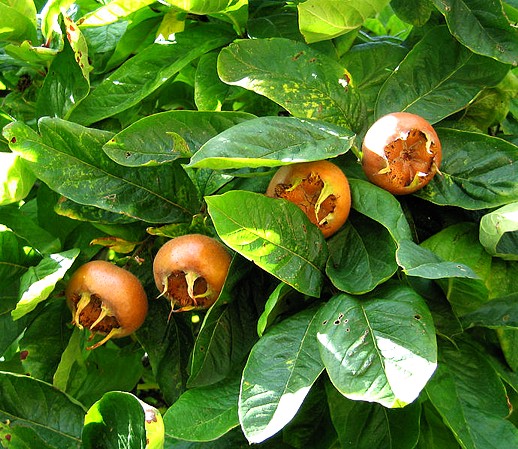
Common Medlar fruit are very hard and acidic. They become edible after being softened ('bletted') by frost, or naturally in storage given sufficient time. Once softening begins the skin rapidly takes a wrinkled texture and turns dark brown, and the inside reduces to the consistency and flavour reminiscent of apple sauce. This process can be a cause of confusion to new medlar consumers, as a softened medlar can give the appearance that it has spoiled.
The Common Medlar was already being cultivated about three thousand years ago in the Caspian Sea region (northern Iran). It was introduced to Greece around 700 BC and to Rome about 200 BC. It was an important fruit plant during Roman and medieval times. By the 17th and 18th century, however, it had been superseded by other fruits, and is very rarely cultivated today. Common Medlar is one of the few fruit that becomes edible in winter, and an important tree for gardeners who wish to try to have fruit available all year round. There are several cultivars, including 'Royal', 'Nottingham', and 'Dutch', which bears the largest fruit. Medlars can be grafted on to the rootstock of another species, for example the pear, to improve their performance in different soils.
Nespolo
del Giappone
Eriobotrya japonica
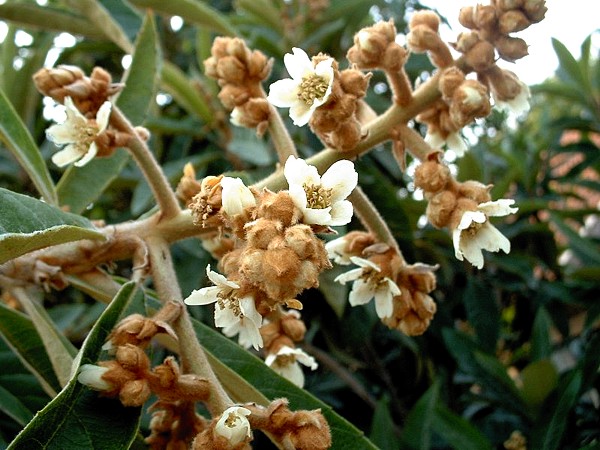
Il nespolo del Giappone appartiene alla famiglia delle rosacee e il suo nome scientifico è Eriobotrya japonica. Si tratta di un albero sempreverde della famiglia delle Rsacee, coltivato per il frutto pregiato, la nespola, costituita da un pomo, giallognolo o arancione, dalla polpa dolciastra e contenente grossi semi bruni. Il nespolo del Giappone è originario dell'Estremo Oriente, ma viene coltivato anche nelle regioni meridionali dell'Europa e degli Stati Uniti. In natura la pianta può raggiungere anche 10 m d'altezza; nei frutteti industriali essa viene, tuttavia, potata e allevata a un'altezza di 4 m circa. È caratterizzata da grandi foglie con nervature molto evidenti e da fiori bianchi e profumati, coperti da una fitta peluria lanosa e riuniti in pannocchie piramidali.
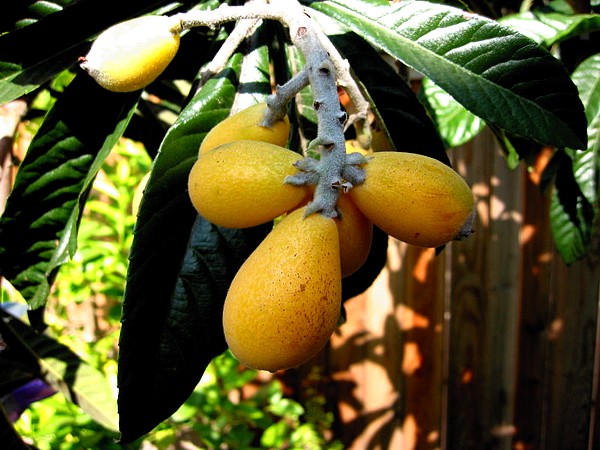
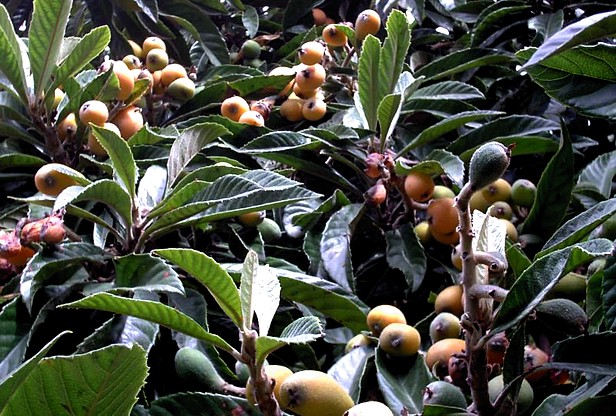
The loquat (Eriobotrya japonica) is a fruit tree in the subfamily Maloideae of the family Rosaceae, indigenous to south-eastern China. It is an evergreen large shrub or small tree, with a rounded crown, short trunk and woolly new twigs. The tree can grow to 5-10 m tall, but is often smaller, about 3-4 m.
The leaves are alternate, simple, 10-25 cm long, dark green, tough and leathery in texture, with a serrated margin, and densely velvety-hairy below with thick yellow-brown pubescence; the young leaves are also densely pubescent above, but this soon rubs off.
Loquats are unusual among fruit trees in that the flowers appear in the autumn or early winter, and the fruits are ripe in late winter or early spring. In Northern California, loquats bear fruit in May. The flowers are 2 cm diameter, white, with five petals, and produced in stiff panicles of three to ten flowers. The flowers have a sweet, heady aroma that can be smelled from a distance.
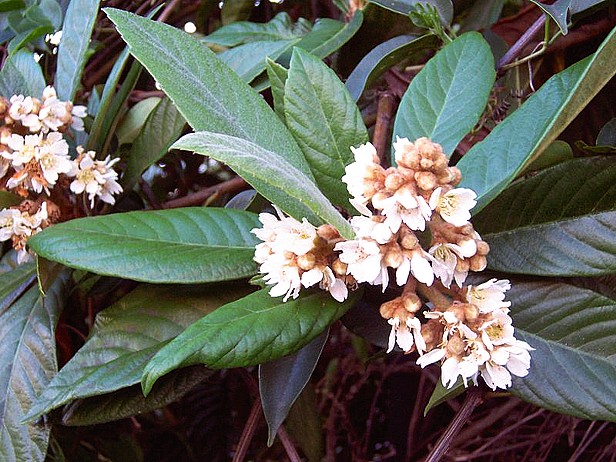
Loquat fruits, growing in clusters, are oval, rounded or pear-shaped, 3-5 cm long, with a smooth or downy, yellow or orange, sometimes red-blushed skin. The succulent, tangy flesh is white, yellow or orange and sweet to subacid or acid, depending on the cultivar. Each fruit contains five ovules, of which three to five mature into large brown seeds. The skin, though thin, can be peeled off manually if the fruit is ripe.
The loquat is comparable to the apple in many aspects, with a high sugar, acid and pectin content. It is eaten as a fresh fruit and mixes well with other fruits in fresh fruit salads or fruit cups. Firm, slightly immature fruits are best for making pies or tarts. The fruits are also commonly used to make jam, jelly, and chutney, and are delicious poached in light syrup.
A type of loquat syrup is used in Chinese medicine for soothing the throat like a cough drop. Combined with other ingredients and known as pipa gao (pinyin: pípágao; literally "loquat paste"), it acts as a demulcent and an expectorant, as well as to soothe the digestive and respiratory systems. Loquats can also be used to make wine.
Like most related plants, the seeds (pips) and young leaves of the plant are slightly poisonous, containing small amounts of cyanogenetic glycocides which release cyanide when digested, though the low concentration and bitter flavour normally prevents enough being eaten to cause harm.
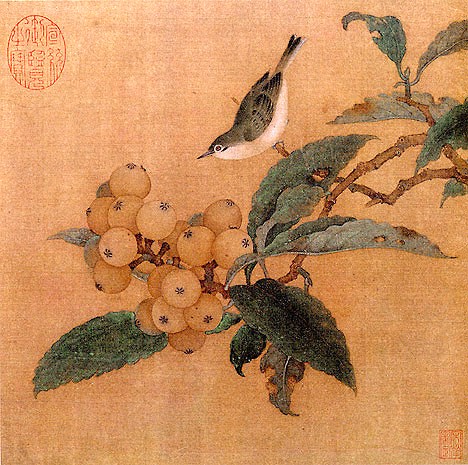
Loquats and a Mountain Bird
by an anonymous Chinese artist of the Southern
Song Dynasty (1127–1279)
The Loquat was introduced into Japan and became naturalised there in very early times, and has been cultivated there for over 1,000 years. It has also become naturalised in India and many other areas. Chinese immigrants are presumed to have carried the loquat to Hawaii. The Loquat was often mentioned in ancient Chinese literature, such as the poems of Li Bai.
Japan is a leading producer of loquats (January to June), followed by Taiwan and China (March to July). They are also grown in the Mediterranean region (for example in Cyprus, France, Israel, Palestine, Italy, Lebanon, Malta, Spain, Morocco, Algeria, Syria, Turkey), and also in Armenia, Australia, Bermuda (where it is commonly used in jam), Brazil, New Zealand, Pakistan, and Portugal.
The Loquat is easy to grow and is often also grown as an ornamental tree; it was commonly grown in California by the 1870s. It also thrives in the humid south-east Texas (Houston) climate, as well as all over Palestine. The boldly textured foliage adds a tropical look to gardens, contrasting well with many other plants.
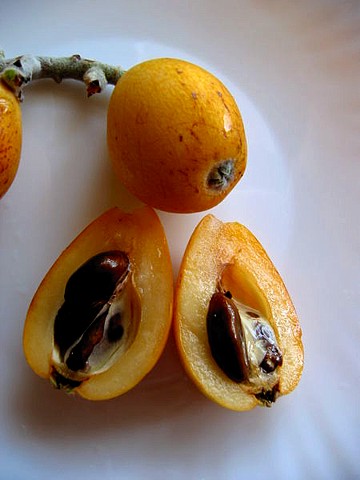
Le néflier du Japon ou bibacier est un arbre de la famille des Rosacées (tribu des Maleae), cultivé comme arbre fruitier dans les régions chaudes pour son fruit comestible, la nèfle du Japon ou bibasse, ou plus largement comme plante ornementale.
C'est un arbre de 6 à 8 m de haut, à port érigé, s'étalant à l'âge adulte. Les jeunes rameaux et bourgeons sont cotonneux (eriobotrya signifie "grappe de laine" en grec).
Les feuilles simples, alternes, persistantes sont de grande taille, 20 à 25 cm de long et fortement nervurées. Elles sont assez coriaces et ont le bord du limbe denté. Leur face supérieure est vert foncé, luisante, tandis que leur face inférieure est tomenteuse et roussâtre.
Les fleurs blanches sont réunies en thyrses. Chose très inhabituelle parmi les arbres fruitiers, les fleurs s'épanouissent en automne ou au début de l'hiver et les fruits atteignent leur maturité durant l'hiver ou au début du printemps.
Les fruits ovoïdes, de couleur jaune orangé, sont des baies à chair blanc jaunâtre, à goût acidulé, très juteuses. Ils portent au sommet les cinq dents persistantes du calice. Les pépins, brun noir, sont d'assez grosse taille.
Cette espèce est originaire d'Extrême-Orient: Chine (Hubei, Sichuan), Japon, Taïwan. Elle est largement cultivée dans les régions chaudes, y compris le bassin méditerranéen où elle peut fructifier normalement, ainsi que dans les régions tempérées pour l'ornement. Elle résiste en effet au froid jusqu'à des températures de - 12 °C, mais ne fructifie normalement que dans les régions où la température hivernale ne descend pas au-dessous de + 3 °C.
Sa culture est très importante au Japon. Il s'est répandu dans le bassin méditerranéen: Algérie, Liban, Turquie, Italie, Espagne, Portugal, ainsi qu'en Amérique du Nord (Californie, Floride, Louisiane, Basse-Californie). Il a également été introduit dans diverses îles du Pacifique et à la Réunion, où il fait l'objet d'une culture généralement familiale et où il peut se montrer envahissant dans les milieux naturels.
Planter au soleil dans un sol bien drainé. Tailler avant la reprise de végétation. La taille en demi-tige permet de maintenir les fruits assez faciles d'accès. La taille annuelle consiste à aérer l'intérieur de l'arbre (novembre) et à supprimer les rameaux qui ont fructifié (l'arbre fructifie sur le bois de l'année). Soin: passer du blanc anti fourmis sur le tronc.
Dans l'hémisphère nord, la floraison a lieu du 1er novembre au 10 décembre selon la variété. La présence d'une plante mellifère en floraison pendant cette période augmente le rendement.
Le néflier du Japon apprécie les arrosages. Il faut supprimer beaucoup de jeunes fruits les années à hivers doux sinon ils restent petits. L'espèce est sensible au feu bactérien.
La propagation est semis possible avec des graines fraîches. La multiplication des variétés de néflier du Japon se fait principalement par greffage. Les porte-greffes sont le franc de néflier du Japon pour les haute-tiges et le cognassier pour les formes naines. Les arbres greffés produisent des fruits dans les deux ans alors qu'il faudra patienter 8 à 10 ans pour un arbre issu de semis. Le néflier du Japon se bouture assez difficilement.
Les fruits (nèfle du Japon) doivent être récoltés mûrs pour être comestibles et, très sensibles aux chocs et aux frottements qui provoquent des taches sombres, supportent mal le transport. Cela limite fortement leur diffusion.